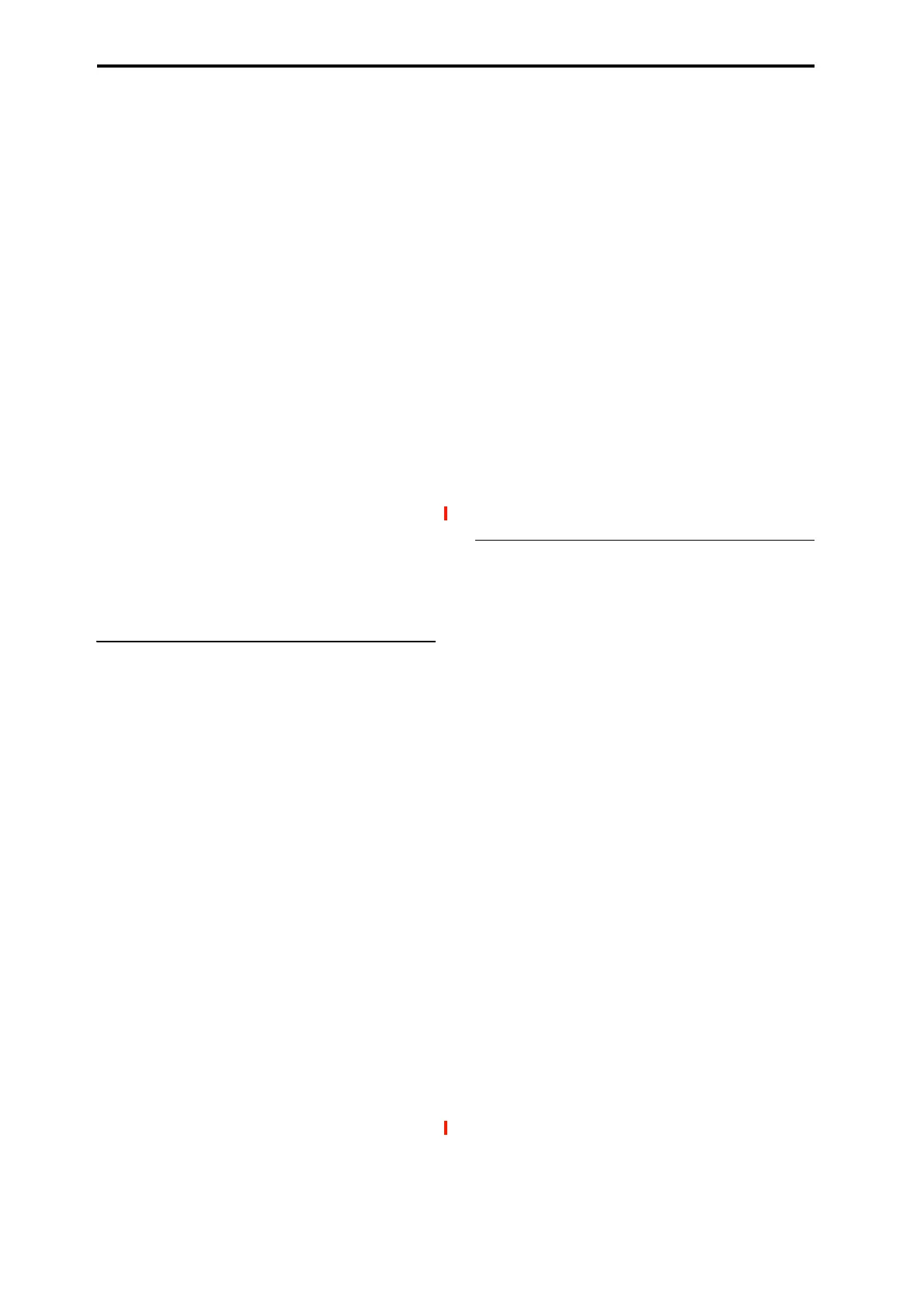EXi: STR-1 Plucked String
240
Bottom-Low [-Inf, –99…+99, +Inf]
This sets the slope between the bottom of the MIDI note
range and the Low Break key. For normal key track, use
negative values.
Low-Center [-Inf, –99…+99, +Inf]
This sets the slope between the Low Break and Center keys.
For normal key track, use negative values.
Center-High [-Inf, –99…+99, +Inf]
This sets the slope between the Center and High Break keys.
For normal key track, use positive values.
High-Top [-Inf, –99…+99, +Inf]
This sets the slope between the High Break key and the top
of the MIDI note range. For normal key track, use positive
values.
Key Follow
To create the classic Key Follow effect, in which the filter
frequency tracks the pitch of the keyboard:
1. Set the Filter Frequency to 30.
2. Set the Keyboard Track Intensity to +99.
3. Set the Bottom-Low and Low-Center ramps to -50.
4. Set the Center-High and High-Top ramps to +50.
5. Set the Center Key to C4.
The settings for the Low Break and High Break keys don’t
matter in this case.
5–3b: Filter EG
The EGs modulate the Filter A and B cutoff frequencies over
time. You can control how strongly they will affect the filters
in three different ways:
• Set an initial amount of EG modulation, using the EG
Intensity parameters.
• Use velocity to scale the amount of the EG applied to the
filter.
• Use any AMS source to scale the amount of the EG
applied to the filter.
You can use all three of these at once, and the results are
added together to produce the total EG effect.
To set up the EGs themselves, including attack and release
times, levels, and so on, see “7–1: EG 1 (Filter),” on
page 248.
Filter A
EG Select [EG 1 (Filter), EG 2 (Pitch),
EG 3, EG 4, Amp EG]
This selects an EG to modulate Filter A’s Frequency.
There are four assignable EGs, in addition to the Amp EG.
Each of these can be used as a modulation source to control a
wide variety of parameters.
In the midst of all this flexibility, we thought it would also be
good to provide a little structure. With this in mind, EG 1 is
named EG 1 (Filter) and EG 2 is labeled EG 2 (Pitch).
Please take these names as suggestions, rather than
restrictions. If you like, you’re free to use these EGs to
control any EG or AMS destination, or to use other EGs to
control Filter Frequency and Pitch.
Velocity Intensity [–99…+99]
This lets you use velocity to scale the amount of the EG
applied to Filter A.
EG Intensity [–99…+99]
This controls the initial effect of the EG on Filter A’s cutoff
frequency, before any velocity or AMS modulation.
AMS [AMS Sources]
This selects an AMS modulation source to scale the amount
of the EG applied to Filter A.
For a list of AMS sources, see “Alternate Modulation Source
(AMS) List” on page 901.
Intensity [–99…+99]
This controls the depth and direction of the AMS
modulation.
Filter B
The EG parameters for Filter B are the same as those for
“Filter A,” above.
When Link is On, or when the Filter Routing is set to Single
or 24dB (4-Pole), all of these parameters are grayed out.
5–3c: Filter Modulation
Filter A Frequency
AMS 1 [AMS Sources]
This selects the first modulation source to control Filter A’s
Frequency. For a list of AMS sources, see “Alternate
Modulation Source (AMS) List” on page 901.
Intensity [–99…+99]
This controls the depth and direction of the Frequency
modulation.
Intensity Mod AMS [List of AMS Sources]
This selects an AMS source to modulate the intensity of
AMS 1.
Intensity [–99…+99]
This controls the depth and direction of the Intensity Mod
AMS.
AMS 2 [AMS Sources]
This selects a second modulation source to control Filter A’s
Frequency. For a list of AMS sources, see “Alternate
Modulation Source (AMS) List” on page 901.
Intensity [–99…+99]
This controls the depth and direction of AMS 2.
Filter B Frequency
The settings for Filter B are the same as those for “Filter A
Frequency,” above.
When Link is On, or when the Filter Routing is set to Single
or 24dB (4-Pole), all of these parameters are grayed out.

